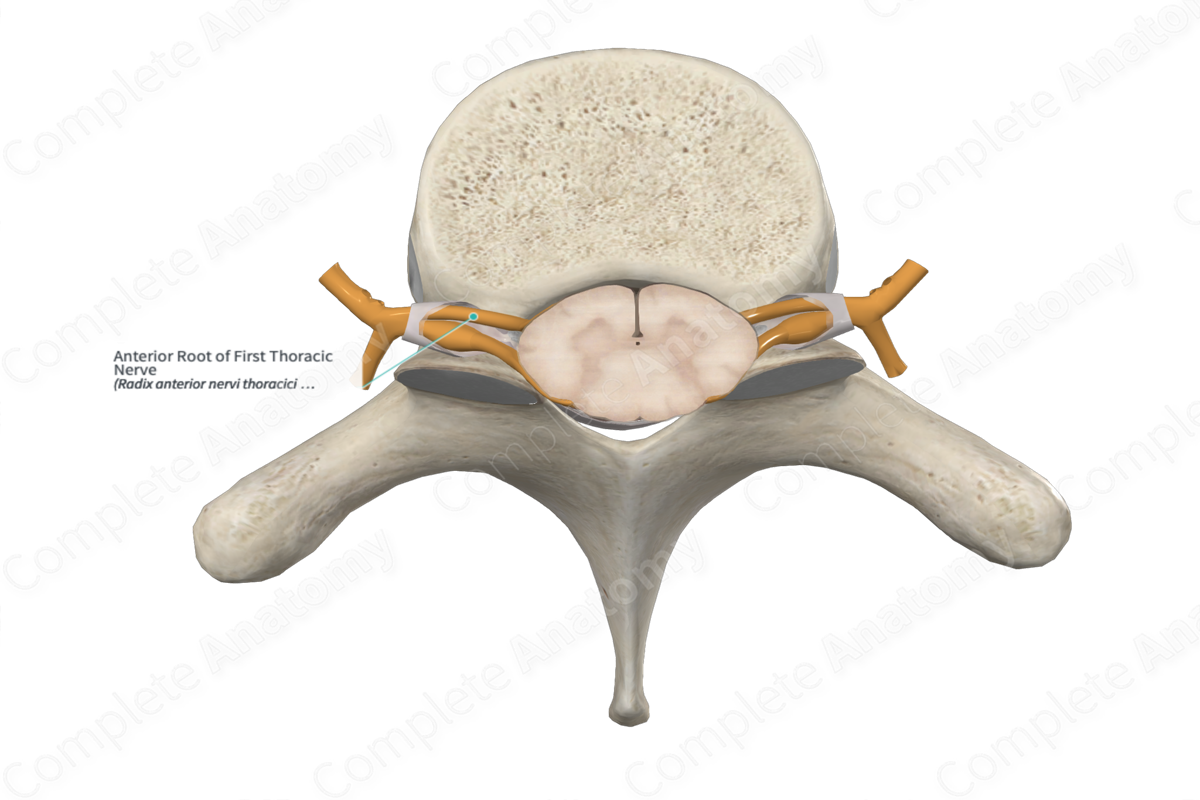
Quick Facts
Origin: Anterolateral sulcus of spinal cord.
Course: Laterally towards intervertebral foramen.
Branches: None.
Supply: Motor innervation to epaxial muscles of upper trunk, intercostal muscles of first intercostal space, muscles of the upper limb innervated by the inferior trunk of the brachial plexus. Sympathetic targets in the head, neck, and territories of first thoracic nerve.
Related parts of the anatomy
Origin
The anterior root of the first thoracic nerve forms from a series of rootlets that emerge from the anterolateral sulcus of the first thoracic spinal segment.
Course
The anterior root of the first thoracic nerve runs laterally and inferiorly away from the first thoracic spinal segment towards the intervertebral foramen located between the first and second thoracic vertebrae. Roughly within this intervertebral foramen, the anterior root merges with the posterior root to form the first thoracic nerve.
Branches
The anterior root of the first thoracic nerve merges with the posterior root to form the first thoracic nerve and does so without branching.
Supplied Structures & Function
The anterior root of the first thoracic nerve supplies all efferents for the first thoracic nerve, both somatic and sympathetic.
The somatic efferents pass through the spinal nerve itself and into either the posterior ramus or the anterior ramus of the first thoracic nerve.
—Those fibers that enter the posterior ramus convey motor innervation to the epaxial muscles, including the erector spinae (iliocostalis, longissimus, spinalis), transversospinal (rotatores, multifidus, semispinalis), and deep segmental back muscles (interspinales, levatores costarum).
—Those fibers that enter the anterior ramus of the first thoracic nerve will give off two branches, one that remains in the intercostal space as the first intercostal nerve, and another that travels laterally to merge with the anterior ramus of the eighth cervical nerve, the inferior root of inferior trunk of the branchial plexus. Efferents of the first intercostal nerve will innervate the muscles of the first intercostal space (external intercostal, internal intercostal, innermost intercostal).
The fibers of the anterior root that enter the communicating branch to the brachial plexus innervate the muscles associated with the lower trunk of the brachial plexus. These are the muscles of the arm, forearm, and hand that are innervated by the median, radial, and ulnar nerves. Additionally, efferents travel via the medial pectoral nerve to innervate the pectoralis minor and pectoralis major muscles of the chest.
Preganglionic sympathetic efferents travel from the lateral horn of the first thoracic spinal cord segment, through the anterior root, and into the first thoracic nerve. Just past the intervertebral foramen, sympathetic efferents leave the thoracic nerve via the white rami communicans to enter the sympathetic chain. The preganglionic sympathetic efferents of the first thoracic anterior root primarily affect sympathetic innervation of the head and neck, with a lesser contribution to the lungs and heart. Sympathetic efferents of the first thoracic root control the sympathetic input to the glands and blood vessels of the upper thoracic dermatomes.



